Colin Spacetwinks is a furry writer and loquacious fan of comic books. Last May, they released an impressive history of the furry fandom using the medium of Twine, an innovative tool for stories and games which allows for endlessly branching narrative strands. Everyone’s A Furry 2K16 not only documents the wildfire-like emergence of funny animal-identified folks since the advent of the internet, but also details a very personal history of utilizing online communities as a space for queer exploration and self-reflection when other options are scarce. Colin and I have had similar experiences growing up with furry, so I asked them to chat about the project and to dish about this and that. This interview has been edited for clarity.
Mouse: Everyone’s A Furry 2K16 is a history of what we call the modern furry community through your own experience utilizing Twine as a storytelling medium. What drew you to use the Twine in particular, taking on this project?
Colin Space Twinks: It was actually sort of strange, because although I talked on and off about furry history all the time – on twitter, on tumblr, wherever – what really motivated it was actually someone asking me about it instead of me going off, apropos of nothing. I got interviewed to talk about some of the economics of the furry art market, and why so many artists seemed to find it easier to generate income and reliable funds, with less hassle from clients, in the commission market there. Once that interview ended, my mind got to thinking about how “Jeez, all the pieces on furry culture and history always tend to come from people on the outside looking in” and how I was kind of tired of that, and how the history of furry itself was actually very poorly documented, scattered about here and there. Add in a bunch of other fascinations, gripes, things on my mind, and suddenly, one afternoon, I research and write this entire piece. I wanted to get something down and out there before other outlets started to really make their own pieces on furry as it was starting to mainstream. Something coming from the inside, and more accurate, as well as featuring personal, more anecdotal pieces that wouldn’t be part of those things. You wouldn’t get “here’s how queer people have connected deeply with furry for years now” in like, say, a Salon piece going “Seriously, what’s up with furries?” for example.
M: Absolutely not. Half my writing on the Hooded Utilitarian is griping about lazy journalism about furries. You do a little digging into furry origins in comics and Science Fiction fandoms, which you might be into if you know to dig into Fred Patten’s archiving but not from outside sources. That early material is fascinating to me, because once furry became a discreet identity, there suddenly was a sharp divide between which comics made the cut to become just “Comics” like Usagi Yojimbo, which debuted in the furry zine Albedo Anthropomorphics and is now a widely respected title, and those which were relegated to this separate lower-grade “furry” status. Omaha the Cat Dancer is important to both, and paradoxically, the series has fallen through the cracks.
ST: You see this especially in the late 90s debates between slices of furry fandom, and later in the early 00s in the ridiculous net war stuff – also pieces of furry history that’d fall through the cracks elsewhere – this desperation into separating things that were “furry,” (bad) or “not furry,” (good), often using the short hand of “anthro” to imply that this wasn’t ‘furry’ – it was good and mature and other people liked it, so it couldn’t possibly be it. You still see it come up sometimes, like when people are talking about Lackadaisy, or other furry media they like, this want to push away from this kind of definition that they despise, or are ashamed of for whatever mix of reasons. This was why I brought up Carl Barks’ and Osamu Tezuka’s material right from the start, because they wouldn’t be classified as ‘furry’ at all by most, yet they absolutely put out erotically charged furry material, relegating them to the bin everything else would get discarded in. Can’t play ‘no, it’s better than that’ when it’s right out there.
M: And independent comics owe a concrete debt to Omaha, in the formation of the Comic Book Legal Defense Fund. But I often find that title conspicuously omitted from the roster of legal victories for comics.
ST: Absolutely. It’s hard to know if it’s intentional, or if Omaha has just been passively forgotten, year by year, despite receiving praise from comics giants at the time, before “furry” was a particularly codified thing. It absolutely hasn’t gotten the kind of canonization a lot of other indie material from the era did.
M: Kim Thompson of Fantagraphics was a champion for interesting funny animal comics. His passing was a blow to American comics in general, but I think in particular to the work of preserving the legacy of work that appeared in anthologies he edited, like Critters. But there’s at some point a cultural split, and you’ve astutely pointed out that it probably has a lot to do with the emergence of the Internet. (Ed. Note, Mouse has worked as an editorial intern for Fantagraphics. Kim Thompson was very kind to her).
ST: Yeah. It’s a really interesting thing, because it doesn’t happen ’till the late 90s and early 00s – and in the early to mid 90s, furry comics are getting printed like wildfire, because the speculator market was ridiculous and everybody was grabbing a slice before it popped. At a time when furry material by furries had some of its greatest mainstream exposure, it wasn’t considered as such – not just yet. It’d take until more people had a net hookup for it to happen. So it’s this strange thing to see, as furry comics retreated back into the domain of the internet, that was when people started picking at stuff from the outside (or, often, from insiders hiding on the outside, for whatever reasons). Cruising through tons of 90s publishers, you can find these old, uncollected furry comics that would’ve been available nationwide, and nobody said a peep. And again, not to mention how Lola Bunny in 1996 blew so far outside of the confines of ‘furry’ that people who know nothing about this whole subculture and the clashes and everything. That she exists in some whole other world.
M: You talk about how there are a few acceptable furry characters, Lola, Gadget Hackwrench, Minerva Mink, who exist in this de-pressurized environment where they are safe to be considered as (presumably cis male) objects of desire, while furry on the Internet kept getting weirder and queerer.
ST: Yeah. That was a crucial point for me, because at the time, when everybody was responding to the 00s stuff, that was when the invention of the ridiculous term ‘fursecution’ came up. Initially, people really thought it was furry specifically that people were hassling and hating… but if you checked all these other forums and websites, what they discussed, and who were “acceptable” furries… in retrospect, it became very clear that bashing furry was mostly being used as a shield to oblique hating queer folks online. Gays, lesbians, bisexuals, trans people, any variety of queer folk. The bad writing of things like Jack and Better Days got their share of slams, but the absolute widest amount of damn near cyber-stalking and harassment was pretty much universally directed at queer folks in the furry community. Because if people were perfectly fine discussing how much they wanted to have sex with these furry women but were constantly picking on gay furries – no matter how serious or ridiculous they may have portrayed themselves, and extra hate for the flamboyant – well, it established a pattern.
M: There’s absolutely resistance, from outside of and also from within the community, to the idea that furry is a vector for queerness, weird sexuality, any kind of unorthodox gender expression, when it clearly is for many, many, many people.
ST: Right. It was a place for a lot of folk who couldn’t find themselves elsewhere offline, didn’t feel comfortable in the spaces they did find. Whatever the case, a lot of people came crawling into furry, finding a place to explore sexuality, gender, in a way the felt… less stressful, I suppose? I think of particular old Furcadia rooms where people were definitely working around and through gender, but somewhat clumsily, lacking the terms or spaces we’d have now. But it was important to have something, somewhere.
M: Like a decades-long therapy session running silently in the background, where you might internalize that you are Mrs. Frisby and Justin the rat is your boyfriend. Or maybe that’s just me. I’m joking (I’m Not). But speaking personally, my furryness is absolutely inextricable from my being a big gay gender weirdo.
ST: Hahaha, we all find ourselves in different ways. Books and movies keep selling this grand, deeply dramatic transformation, but an astounding amount of us, especially in the modern age, work out our sexuality and gender in weird online spaces. We don’t have the big slow-mo zoom-in moment where we go “And then I knew” over appropriately dramatic and meaningful material. A lot of us get there in ways that certainly wouldn’t be your award bait for just sounding too goofy, too ridiculous. People want your sexuality, your gender exploration to be this Serious Affair, and it absolutely can be in these spaces, but people don’t wanna admit that people do an awful lot of processing in these spaces.
M: Sometimes your “eureka” moment, if you have one, is looking at a pink husky’s butthole on the adult section of Furbuy.
ST: Hahaha, yeah, pretty much! So the whole history of furry, in comics, zines, and everything, is wrapped up in a whole bind of sexuality, especially moving out from the 90s and into the 00s, with a lot of furry webcomics in particularly delving into homosexuality and gender exploration.
M: Going to college to be gay was, and is, a THING in furry comics.
ST: Absolutely! Oh god, it was massive!
M: It gets a lot of teasing but I love it. I love Associated Student Bodies. A good friend just sent me some issues of Circles in the mail. I read the Class Menagerie as a kiddo. They’re clumsy and arguably amateur if you choose to think about it that way, but they speak from a place of real earnest gay longing that, as you’ve mentioned, mainstream comics publishers are absolutely inept at capturing.
ST: Exactly! They’re clumsy, yes, but like, they feel more real for it. We didn’t have the poetic words, the glorious prose, the Serious Stories, so we just worked ourselves out online in these webcomics and written serials that were very sincere, very honest ways of working through ourselves. Like, 1998, 199, it’s… 4 years till MA legalizes gay marriage? It’s not even thought of as a possibility at the time, and we find ourselves craving these places to be open and safe with our sexuality and gender thoughts, but also wanting to talk about the struggles we feel too… So we end up with a lot of “gay at college” comics, tackling both of these – where we can be very very queer and simultaneously mention “Hey, shit SUCKS for us,” inventing a space for ourselves in our fiction we don’t find IRL.
M: Associated Student Bodies, I think has a feeling of, hm… “This comic is about cartoon lions and wolves, so maybe this is a world where condoms aren’t necessary.” Circles on the other hand is very candid about its characters living with HIV/AIDS. They’re maybe not mutually exclusive approaches to processing things.
ST: It’s just processing, non-stop, basically, and everyone having room to do that in their own unique way, while creating a community. Not to mention, furry gave an alternative if you didn’t like or feel comfortable with what queer mainstream gave you, if you had spaces or access to it in the first place.
M: AYEP.
ST: There’s all this very corny art of stuff like watercolors of gay coyotes looking up at the stars you can find in VCL artists from the time – and it was so different than what a lot of mainstream gay material sold you then. This sort of sweet, romantic sensibility, and yes, very, very corny. But we wanted corny! Not to mention, the freedom of having all sorts of different kinds of bodies. If we think modern gay mags and the like are bad at offering body variety… hooh, the 90s. So we latch onto this world of modern or fantasy set walking, talking animal people having these dramatic and clumsily written gay romances and It means the world to us, because so much of it is us, and so often, made by us. Inventing what you don’t have. You can find it in the print material, but especially in the webcomics.
M: Definitely.
ST: Even back then, webcomics were so big you couldn’t possibly read them all – and there were so many in the furry field, just… processing! But all people want to latch onto is the “legitimate” stuff, so Blacksad keeps coming up on the “good” furry content lists, and the like, and, notably Blacksad runs into the same heterosexual stuff – making the women less furry, more ‘acceptably’ sexy. If the artist considered Blacksad sexy, he’d be drawn with just cat ears and a weird nose for animalistic features.
M: I’ve had my words with Blacksad.
ST: Haven’t we all!
M: I can always spot a furry in comics if they draw furries well. That’s a little obtuse, maybe, but hoo-boy, there are some gruesome drawings of Rocket Raccoon out there.
ST: Hahaha, it’s like I’ve said elsewhere, drawing animals and animal people have dropped out of superhero artist fundamentals, for want of just imitating Jim Lee. But now we end up in a weird point in 2016, where after all this, after all those inner and outer and inner-outer debates and wars… less and less people care about the old stigma of furry. It’s a weird place to be!
M: We have Zootopia. I’ll call it out as furry (those are some well-cartooned animal peoples), plenty of others are at liberty to not do so for their own comfort. But we’re getting around to your thesis. Everyone’s a furry. Or from its evolution from mainstream funny animal cartoons to a specific subculture to big business again, there’s something special about cartoon animals.
ST: Yeah. After all this, all that hemming and hawing, people making ‘exceptions’ for certain furries, just time passing made a lot of the old rules about what was acceptably furry and not just started to drop. Like, Disney puts out a movie with a furry nudist colony featuring a panther luxuriously licking at his leg and buff tigers in sparkle short shorts dancing all around. And people are just… going with it. Drawing their own fursonas or furry comics without having to go “it’s ANTHRO” or all of that. So now people are re-embracing it, whether or not they know any of the history behind how we got there in the first place.
M: So much of it gets lost, in dead links or in the hearts of people who for whatever reason no longer want to be part of the fandom, or in new folks swept up in just the tidal magnitude of new material being produced all the time. Burned furs ghost and resurface as porn publishers, or folks need to dip out to avoid the constant teasing or harassment, or maybe they’ve gotten through their processing and are at the time in their life when furry isn’t necessary for working their stuff out.
ST: It’s a lot. I chat regularly with a former Burned Fur, who read the twine and like we went back and forth about the history there. I did some old net spelunking and tracing the other day, found one artist who quit furry in about ’99, ’00, and now just recently has a furry body pillow up for sale. Some people have quit permanently and are never coming back, some are returning in quiet waves. Some never left, and chugged on quietly – Terrie Smith, iconic 90s furry artist, never stopped, and even has Havoc Inc as a webcomic that’s been stuck on a cliffhanger since 2013, I think. People worry about mainstreaming and furry not ‘being cool’ or some exclusive club, but like, fuck that, for all the obvious reasons.
M: I love Terrie Smith.
ST: She’s fantastic! Really molded and influenced so much of the 90s furry style – watercolors and markers, really vivid.
M: And Havoc, Inc. was about a gay relationship that Marvel and DC wouldn’t touch.
ST: And still are awfully skittish about, when they feel confident enough to try at all.
M: And if you’re on the net, you get to see the dirty stuff, how Ches and Deck are definitely polyamorous. Things about those characters that weren’t exactly printable, even in the boom of black-and-white comics.
ST: Yeah. Like, you can find het couples being sexy and sexual, especially in 80s superhero stuff, like Green Arrow and Black Canary – but get to gay, and it’s almost always happening off panel, if it happens at all. Lots of very chaste, very adorable gay boys, who barely so much as kiss. Steve Orlando, thank god, broke this pattern in the biggest ways with Midnighter.
M: Growing up on furry comics, seeing something from marvel like “Oh, Doctor Strange is gay now and also dead” just doesn’t impress me.
ST: Ahaha, it’s also rough times, because any gay character you get in superhero comics now can’t possibly last, especially as a solo – they don’t have time to develop, they can’t get a supporting cast, they can’t be themselves, they can’t have a full story. The print market doesn’t have the economic security it used to, so constant reboots and events happen, and when publishers do take a whack at something different, everyone knows they’re running on a very tight clock. So if you want to get the real stuff, the space to really deal with these things, you get online. Back then, and now. A lot of queer characters, especially at Marvel now, end up on team books, where their only other queer interaction is with their designated romance, if they get one at all. There’s no queer life – there’s very limited slots for interaction, and their almost never the lead character. And again, they’re on a ticking clock, and if they’re in a teambook, they surrounded pretty much entirely by straight people… So it’s bread crumbs. Well meant breadcrumbs, but bread crumbs. In comparison, the sincere clumsiness of a 1998 “gay at college” furry webcomic is a fucking feast.
M: And the state of furry now is… implicitly queer. Or is it? To be honest, I don’t follow along with too much straight furry culture these days.
ST: THIS is where mainstreaming gets weird. I don’t worry about furry ‘not being cool’, I worry about queer furries getting pushed out, and the worst aspects of furry communities – homophobia, transphobia, racism, et all – getting amplified. And lacking a clear history, one of the things I wanted to try and rectify, it’s very easy for one to come in and claim “oh, yeah, it’s always been very straight here in furry”. Which isn’t helped by outside “legitimate” pieces on furry culture either intentionally or unintentionally always focusing on het stuff. So I don’t know if it’s implicitly queer right now! It absolutely was when so much of the net was hell bent on hating furry, but right now? It’s in flux. People have to sort of assert and be loud about the queerness of furry space and not let people revise history or push queer folks out to make it ‘acceptable’ and very very straight.
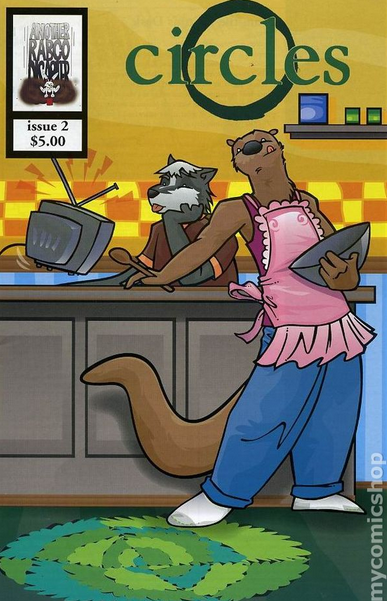 Cover by Chris Goodwin
Cover by Chris Goodwin
M: So to me it’s absolutely necessary for pieces like Everyone’s A Furry 2K16 to be out there to document our history in an environment when lazy journalists invent things about us out of whole cloth, or can’t even report on violent attacks on us without breaking out into laughter. To present a personal history, which fills in so many gaps in between bullet points.
ST: Yeah. It meant a lot to me when I started getting responses from people who have been in furry since the 70s, 80s, thanking me for writing a piece like this, capturing stuff people either don’t see or intentionally ignore. So while furry’s starting to “legitimize”, I don’t want that legitimization to come with the cost of draining furry out of all its queerness, its safe spaces for queerness – which its already lost some, to either tech obsolescence or just getting pushed out – and amplifying all the worst aspects we have, just like any subculture has. It does make me feel better that a lot of the old guard, the really shitty ones, don’t have the pull they used to. People don’t like what they’re selling, or aren’t paying attention to them in the first place.
M: It’s not a monoculture or really even a “fandom.” I’ve had the great fortune of finding my friend group, and hey, my spouse(!) through furry. I can insulate myself from the heinous behavior that does go on, like it does in any social group. But I agree, we need to speak up for ourselves, for or reasons for being here.
ST: Yeah, it’s definitely different than things like anime fandoms or the like, because there’s no central… professionally produced piece we circle around. We make our own things, we have dozens upon dozens of subgroups. All that’s really similar is an enthusiasm for talking animal people. Not even everybody in furry has their own fursona, it’s a really wide variety of interests in this one thing. So yeah. One of the things I’m trying to do with and after Eveyone’s A Furry 2K16 is get that history in. I’m trying to push myself to start getting some of those 90 print comics and zines, sort of assemble a library and timeline of all this stuff that has become forgotten… because who would’ve ever thought it’d be important? And maybe, hopefully, get Omaha The Cat dancer some of the recognition it lost back.
M: GODSPEED!

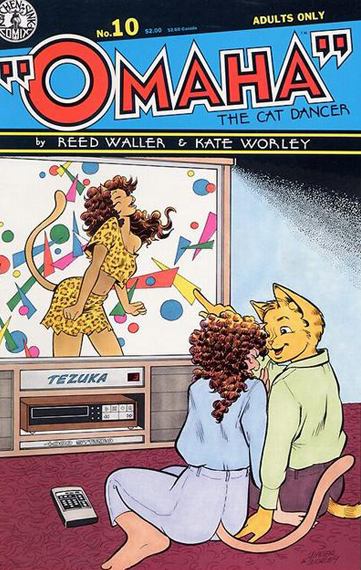

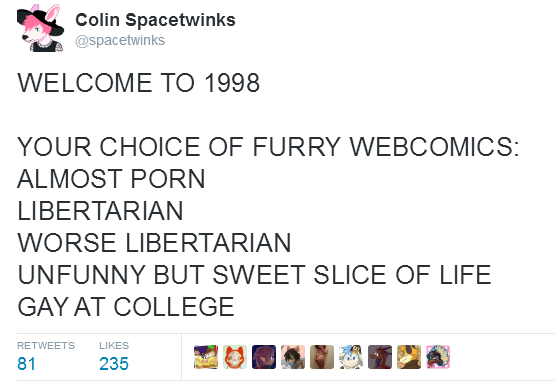
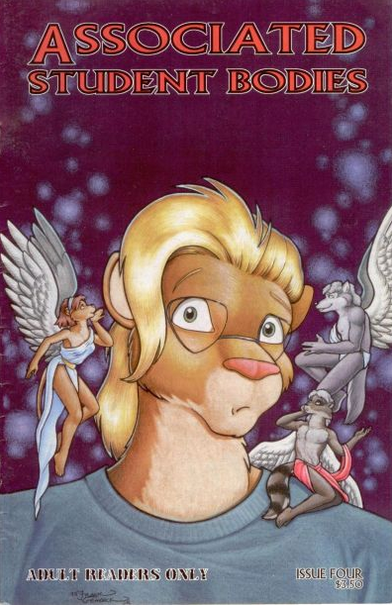
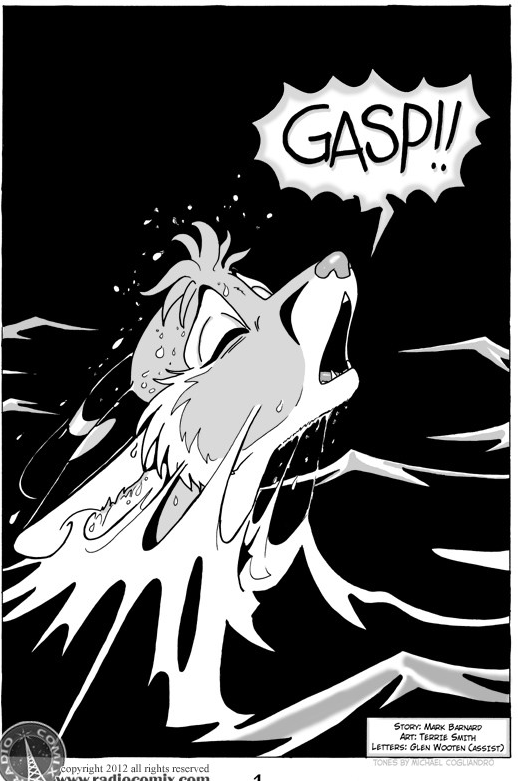
That was…actually a pretty interesting article, to be honest. Decent, quick read. Omaha has always been one of my favourite anthro comics (props for the mention of Critters and Kim Thompson, too)–any ideas as to why it’s slipped out of favour? MOST of it still stands up today in my opinion. I really would like to see it get some recognition back, it truly deserves it…..
Pingback: FUTURE FURSUITING: furry’s most original creations and the rise of tech-enabled smart suits. | Dogpatch Press